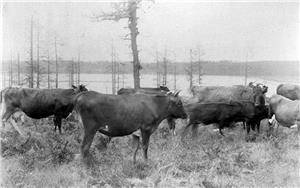On March 17, 1894, 18 Dutch colonists, including a cheesemaker, arrive at Oak Harbor on Whidbey Island.
The Northern Pacific Railroad reached Puget Sound in 1887 and the Great Northern Railway pushed through in 1893. The railroads opened the floodgates of migration spurred by land speculators selling logged-off land and the railroads selling tickets and their own lands. The Northern Pacific acquired public land through grants from the U.S. government or by purchase at $1.25 an acre. The railroad sold off large tracts to land companies, which embarked on various schemes to attract farmers too late for free homesteads.
In 1894, John "R.E." Werkman acquired the right to market land around Oak Harbor for one of the land companies and he visited Holland, Michigan. He placed newspaper ads in Dutch to attract buyers and he displayed foot-long potatoes to impress farmers. This resulted in the arrival of the steamer Idaho at San de Fuca on Penn’s Cove on March 17, 1895, with 18 Hollanders plus an expert cheese maker direct from the Netherlands. More colonists stepped off the boat the following November.
Within two years a community of 200 Hollanders had made their homes at the north end of Whidbey Island. Many settled in Clover Valley to the north of Oak Harbor, along Crescent Harbor, in Swantown, in San de Fuca on Penn's Cove, and they quickly earned recognition for their thrift and industry. The influx of these energetic citizens helped the area recover from the Panic of 1893, the worst economic downturn in U.S. history before the Great Depression.
More Dutch settlers followed during the 1890s, and to this day Oak Harbor has a Dutch ambiance, and celebrates "Holland Happening Festival" each April.

